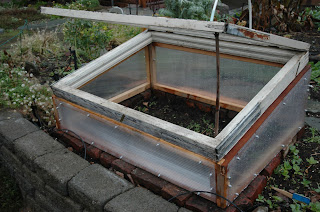February is the most hopeful of all months to a gardener. Buds are swelling, shoots are poking and days are lengthening. What else could you want?
Well...if you’re a maritime Northwest gardener, maybe a little less rain and a little more warmth. You can’t change the weather—entirely—but you can create little microclimates to make early spring gardening easier and more successful. Do it by using a cloche or a cold frame.
Putting a cloche or a cold frame over your bare garden soil will warm the soil (2-3 degrees with a cloche, double that with a cold frame), and dry it out so it can be planted sooner. But the cloche or cold frame could also be used as a mini-greenhouse for starting flats of seeds like lettuce, which will germinate in soil that’s 45 degrees. Or you could harden-off your potted starts before putting them in the ground.
Be warned, though: you have to keep a close eye on your seedlings. They may need water daily, and you might have to open the cloche or cold frame to vent it on warm days so you don’t cook the plants. Keep a garden thermometer in the soil and a regular room thermometer also in the device, so you can monitor your microclimate.
You can buy pre-made cloches and cold frames, but you can also build them yourself. Here are some building basics:
 |
| Photo: Bill Thorness |
An alternative to PVC is to use metal hoops made of bendable wire and stretch the sheeting over it. Wire hoop kits are not commonly found in stores, but Canadian company Lee Valley Tools sells 76-inch-long wire kits that bend to cover a three-foot-wide row about 20 inches high.
Stretch a piece of heavy, clear sheet plastic (at least 6 mil) over the hoops, leaving enough on each side to reach the ground. Use “garden clips” (found at Territorial Seed Company, which sells many season-extender supplies) to hold the plastic onto PVC, or office-supply-store alligator clips if using wire hoops. Anchor the plastic onto the ground all around the cloche with bricks or lengths of board.
 |
| Photo: Bill Thorness |
The solid glass of an old window makes a great cold frame lid. The box can be built with 2x2 untreated wood, cut and screwed together into rectangles for the front and back, shorter in front and higher in back. The sides will be a bit trickier to cut, because you will be creating an irregular shape that accounts for the height of the front and back.
You can enclose the sides with wood, but I use polycarbonate sheet plastic. Its clear sides allow more of our weak spring sun into the cold frame. Screw the pieces of each side together, so they can be disassembled when pieces of wood rot (please don’t use treated wood). Attach the top to the back with galvanized steel hinges, and attach a cord to the top and to the side so that the top won’t fly open too far if you open it on a windy day. Keep a wedge of scrap wood or a brick handy to prop it open for venting.
Set the cold frame on a bed of bricks, situated so that the slanted lid faces the sun with the least shadow at high noon. Let the soil dry for a week or so before planting.
Bill Thorness will be speaking on Year-round Edibles: Best Growing Techniques and 10 Steps to Your Best Tomato Year Ever at the Yard, Garden & Patio Show. He is a Seattle-Based freelance garden writer and author of Edible Heirlooms: Heritage Vegetables for the Maritime Garden. He writes for numerous regional publications, including The Seattle Times, Seattle Met magazine, PCC Sound Consumer and Oregon Tilth's In Good Tilth. He also authored the guidebook Biking Puget Sound and has been a biking gardener in Seattle since the mid-1980's.
Editor Note: This inspired cold frame caught my eye at the 2010 Northwest Flower & Garden Show. It looks like a fun way to add some year round color to the veggie garden.


Nice complete article. I've seen good success with both cloches and cold frames. I've found they're a little tricky where I am in Texas, because one day it'll be freezing cold and the next day it'll be 75 degrees. Pretty erratic weather. But they certainly do protect your plants.
ReplyDeleteTheGardenCloche.com | Quality Plant Covers
That is a colorful cold frame - I should paint mine!
ReplyDelete